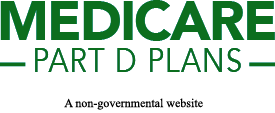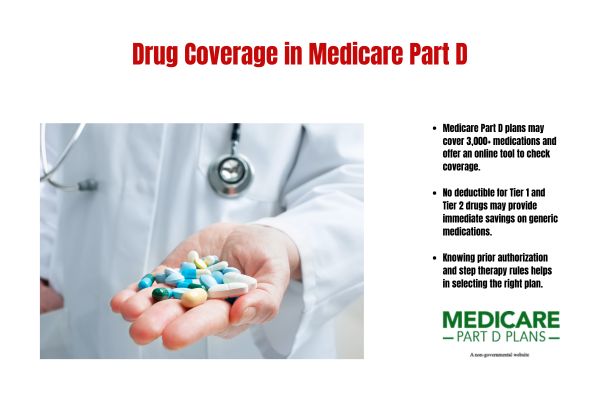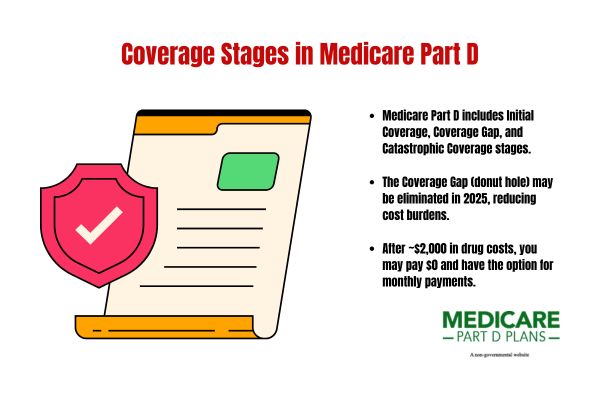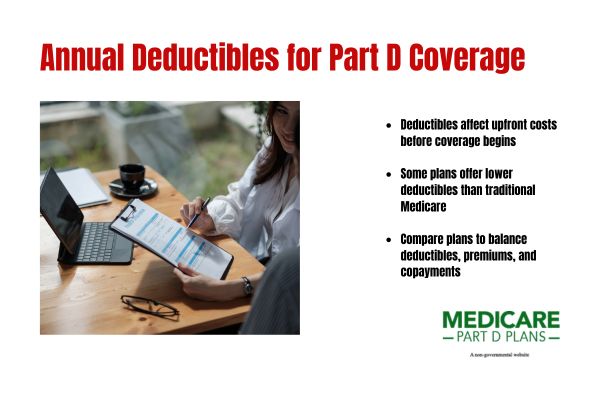Find a Medicare Part D prescription drug plan

Medicare Part D
Prescription Drug Coverage 2026
Part D Medicare Covers
Medicare Part D covers prescription drugs, such as medications for chronic conditions and short-term treatments. This article explains what Part D might include and how it could help you manage your costs effectively.
Key Takeaways
- Medicare Part D will likely provide essential prescription drug coverage to Medicare beneficiaries, helping manage medication costs through private insurance plans.
- The coverage is structured in three phases: Initial Coverage, Coverage Gap (Donut Hole), and Catastrophic Coverage, which might affect certain out-of-pocket costs throughout the year.
- Beneficiaries may utilize financial assistance programs like Extra Help to potentially reduce costs and should actively compare plans to maximize their coverage and savings.
Overview of Medicare Part D
Medicare Part D will likely be a vital component of the Medicare program that provides prescription drug coverage to help reduce the costs of medications. It is available to all individuals enrolled in Medicare, possibly offering significant savings on prescription medications.
This coverage may not be automatically included with Original Medicare (Part A and Part B); instead, it will likely be offered through private insurance companies that are approved by Medicare.
Obtaining a Medicare Part D plan could help individuals manage their drug costs more effectively. This may be especially beneficial for those relying on regular medications for chronic conditions or other health issues.
The coverage will likely extend to various types of medications, from those needed for chronic conditions to short-term treatments, likely making it an essential part of comprehensive healthcare planning.
Drugs Covered by Medicare Part D
One of the main aspects of Medicare Part D will likely be understanding which prescription drugs may be covered. This broad range might include medications for chronic conditions like diabetes and hypertension, as well as short-term treatments for acute illnesses.
This could potentially ensure that whether you need ongoing treatment or temporary relief, your Medicare drug coverage and Medicare Part D plan have you covered.
In addition to medications, Medicare Part D may also cover certain adult vaccines covered at no cost to members as of January 1, 2023. However, it’s important to note that some medications covered under Original Medicare Part B may not be included in Part D coverage.
Plans may have specific requirements or limits, such as needing prior approval, quantity limits, or trying lower-cost alternatives first. Failure to get prior approval for certain drugs may result in having to pay the full cost out-of-pocket.
Each Medicare Part D plan includes a formulary, or a drug list of covered drugs, to help manage these aspects. This plan’s list might vary between plans, so it’s essential to review the formulary when choosing a plan to ensure it covers the medications you need.
Network pharmacies and sometimes preferred pharmacies may also impact costs, so understanding where you could get the best prices will likely be crucial.
Coverage Phases in Medicare Part D
Medicare Part D coverage is structured into three primary phases: the Initial Coverage stage, the Coverage Gap (often referred to as the Donut Hole), and the Catastrophic Coverage stage. These phases may reset at the beginning of each plan year, typically on January 1. Knowing the details of each phase could help in anticipating prescription drug costs throughout the year.
During the Initial Coverage stage, you might pay a set coinsurance or copayment for your prescriptions until you reach the coverage limit. After this limit has been reached, you enter the Coverage Gap phase, where your drug costs may increase temporarily to help cover the costs associated with your prescriptions.
Finally, once your out-of-pocket expenses reach a specific threshold, you enter the Catastrophic Coverage stage, where your costs may be significantly reduced.
Initial Coverage Stage
During the Initial Coverage stage:
- You will likely be responsible for copayments or coinsurance for your medications.
- This might mean you pay a fixed amount or a percentage of the drug cost at the pharmacy.
- This stage will likely continue until your total drug costs reach a predefined limit.
- After reaching this limit, you move into the next phase, the Coverage Gap.
Coverage Gap (Donut Hole)
The Coverage Gap, commonly known as the Donut Hole, is a temporary phase in Medicare Part D where you might experience higher out-of-pocket costs for your prescription drugs. This phase likely begins once your total drug costs exceed the initial coverage limit. While in the Coverage Gap, the cost of your medications may be higher, which could be a financial burden for many.
However, some strategies to manage costs during this phase might include:
- Utilizing mail-order pharmacies
- Opting for generic drugs
- Choosing less expensive brand-name drugs
These approaches could potentially help lower costs, save money, delay, or avoid paying to enter the Coverage Gap.
Additionally, individuals who receive Extra Help may be shielded from the Coverage Gap and might not experience these increased costs.
Catastrophic Coverage Stage
The Catastrophic Coverage stage is the final phase of Medicare Part D. Once you reach this stage, your out-of-pocket costs could drop significantly. At this point, you may no longer have to pay for your covered prescriptions.
This phase will likely provide substantial financial relief, possibly ensuring that those with high medication costs are not burdened with excessive expenses.
Potential Costs Associated with Medicare Part D
Understanding the possible costs associated with Medicare Part D is crucial for managing your healthcare budget. These costs may vary significantly based on the selected plan and might be influenced by several factors, such as your income. Overall, these costs might include:
- Monthly premiums
- Annual deductibles
- Copayments
- Coinsurance
Each of these will likely play a role in your total out-of-pocket expenses.
Total expenses under Medicare Part D may also be influenced by the number of prescriptions you need, how often you use them, and the specific agreements your plan has with pharmacies. Additionally, costs may be lower for those who qualify for financial assistance programs like Extra Help.
Monthly Part D Premiums
Monthly premiums will likely be a fundamental cost component for standalone Medicare Part D plans. The amount you pay may vary significantly depending on the specific plan you choose. If you didn’t sign up for Part D when first eligible, you might face higher monthly Part D premium due to late enrollment penalties.
Comparing various plans and their premiums could help in finding one that fits your budget and medication needs.
Premiums may also be influenced by your income, with higher-income beneficiaries potentially paying more. Staying informed about your premium costs and the factors that might affect them could help you manage your overall healthcare expenses effectively.
Annual Deductibles and Copayments
The annual deductible for Medicare Part D plans
Knowing these deductible and copayment amounts will likely be crucial for effectively managing your prescription drug costs.
Copayments are fixed amounts you pay for your medications, while coinsurance will likely be calculated as a percentage of the drug’s cost. These costs might add up, so knowing what to expect and planning accordingly could help you stay within your budget.
How the Inflation Reduction Act Impacts Medicare Part D
The Inflation Reduction Act will likely bring significant changes to Medicare Part D, aimed at enhancing financial support and accessibility for individuals with Medicare. One possible change might be the improvement in out-of-pocket cost thresholds, which could help reduce the financial burden on beneficiaries.
Lowering the maximum out-of-pocket costs through the Inflation Reduction Act may also make certain medications more affordable for people with Medicare. These changes could be particularly beneficial for those who rely on expensive drugs or have chronic conditions that require ongoing treatment.
Choosing a Medicare Part D Plan
Choosing the right Medicare Part D plan will likely be a critical step in managing your prescription drug costs. Points to consider may include:
- Medicare Part D coverage will likely be provided through private insurance plans approved by Medicare.
- Premiums may increase if you enroll late.
- Enrolling when first eligible could help to avoid higher costs.
Reviewing the plan’s formulary, network pharmacies, and additional benefits is also essential.
See plans in your area instantly!
Advertisement
Financial Assistance Programs
For those with limited income, financial assistance programs like Extra Help could potentially reduce the costs that may be associated with Medicare Part D.
The Extra Help program:
- Will likely be designed to lower Medicare Part D costs for individuals with limited income and resources.
- Bases eligibility on both income and resources.
- Allow some individuals to qualify automatically without needing to apply.
To qualify for Extra Help, applicants must provide documentation such as bank statements and tax returns.
Once qualified, beneficiaries could potentially have their monthly drug plan premium and deductible reduced to zero, and their out-of-pocket costs for covered medications may be significantly lower.
The Extra Help program may be applied for at any time, likely providing a valuable safety net for those in need of rest.
Using Your Medicare Part D Coverage
Making the most of your Medicare Part D coverage will likely involve understanding how to use it effectively. One way to save on prescription drug costs might be utilizing mail-order pharmacies, which could offer lower prices compared to traditional pharmacies.
Additionally, asking your doctor about switching to generic or less expensive brand-name drugs might help you manage costs more efficiently.
Medication home delivery services may also be a convenient option, which could offer several benefits:
- May reduce the need for frequent trips to the pharmacy by shipping refills directly to your home.
- Some plans might prescription refill reminders through text or email, helping you stay on top of your medication schedule.
- Automatic refill programs could potentially ensure that you receive your medications continuously without needing to reorder, likely providing peace of mind for those with chronic conditions.
Beneficiaries should switch their Medicare drug plans only during specific enrollment periods, except for those on Medicaid, which might change plans monthly starting in 2025. Utilizing mail-order pharmacies may also help delay entering the Coverage Gap, likely making it a valuable strategy for managing your prescription drug costs.
Find a Plan and Enroll Online Yourself!
Advertisement
Summary
Understanding Medicare Part D is crucial for effectively managing your prescription drug costs and ensuring you have access to the medications you need. By familiarizing yourself with the coverage phases, associated costs, and available assistance programs, you can make informed decisions that could lead to better health outcomes and financial savings.
Empower yourself with knowledge, utilize the available resources, and take advantage of the financial assistance programs if needed. With the right plan and strategies in place, you can navigate Medicare Part D with confidence and peace of mind.
Frequently Asked Questions
How much does an enrollee pay in coinsurance during the initial coverage phase for covered Part D drugs?
During the initial coverage phase for covered Part D drugs, an enrollee might pay up to 25% in coinsurance.
What happens during the catastrophic phase of the Part D benefit?
During the catastrophic phase of the Part D benefit, enrollees might not pay cost sharing for covered drugs, while sponsors may cover approximately 60% of the associated costs. This phase could provide significant financial relief for those who reach this level of spending.
How does the Inflation Reduction Act impact Medicare Part D?
The Inflation Reduction Act will likely enhance Medicare Part D by lowering out-of-pocket costs and may offer subsidies for specific drugs, possibly making medications more affordable for beneficiaries.
What is the annual deductible for Medicare Part D plans?
The annual deductible for Medicare Part D plans is set at $590.
How can I avoid or delay entering the Coverage Gap in Medicare Part D?
To avoid or delay entering the Coverage Gap in Medicare Part D, utilize mail-order pharmacies, opt for generic medications, and select more affordable brand-name drugs. These strategies could help manage your out-of-pocket costs effectively.
Begin Choosing your plan
Advertisement
ZRN Health & Financial Services, LLC, a Texas limited liability company.




